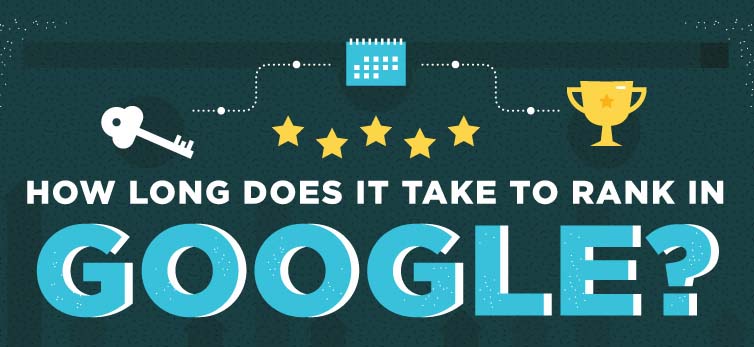It is a question I get again and again and again, from those with new sites as well as though with older sites that are less than SEO-friendly.
A typical answer would be, “Well it all depends…” which is not so far from the truth. With so many variables to consider including the site’s domain authority, on-page SEO best practices, off-page SEO factors as well as competing sites, one site can rank on the first page of Google faster than another.
The team at Ahrefs recently conducted a study where they sifted through their own historical ranking data in order to give the online marketer a better understanding of how long it takes to get ranked on Google and why some sites get there faster than others. Then the folks at The Website Group in the UK put the results all together in a pretty infographic.
With no further ado, here is the infographic in its full glory and I’ll add some suggestions and comments below.
[Click here for full size version]
A couple of big takeaways from this research:
Only 5.7% of all studied pages ranked in the Top10 search results within 1 year for at least 1 keyword.
and…
The majority of these managed to achieve that in approximately 61 to 182 days.
This is not too encouraging if you are launching a brand new site and have the expectancy that “just because you launched,” droves of traffic will be coming. In fact, it could take months and months for that traffic to come, and that is only if you do something to affect all of the variables mentioned above.
What Can You Do To Affect Variables?
There are things that you can and should do when launching a new site that can help you be one of those 6 or so percent referenced in the study.
Get Domain Name & Launch a Site ASAP
If you are planning a new site and/or business, get a domain name ASAP and then put up some kind of splash page. It could say “Coming Soon!” or “Sign up for Updates.” The main idea here is to get something up and then make sure Google finds it and crawls it. This can be done by getting a link (or links) from sites that Google has already indexed and/or verifying your new site and submitting a XML sitemap in Google Search Console.
It may take months to develop a new site but in the meantime, at least your domain and splash page are maturing. If it takes 4 months to finish your site, at least you are 4 months in to the average 2 to 6 months that only a small percentage of sites get to the first page of Google.
Implement an On-Page SEO Strategy
While there are many, many things one can do to market online these days, the foundation for any web site is having a good on-page SEO strategy in place. This includes making sure keyword research is done well, target keywords and phrases are mapped to appropriate site pages, title tags and meta description tags are optimized, content is well written and reflects the target key phrases for each page, images are optimized for size (fast loading) and include optimized alt and title attributes, interlinking between pages, making sure site is responsive so that it easily adapts from desktop to tablet to mobile, and making sure the site and pages load quickly.
This is not an all-inclusive list but are some of the main elements that constitute SEO best practices. You are wise to launch your new site with these already in place. You can always make adjustments later.
Start Producing Content That Has the Potential To Earn Links
If you are waiting months for a new site to be developed, why not start creating content now? It does not have to be published all at once but rather can be staged and spread out over time. The main idea here is to use any downtime that your site is not online to come up with content ideas, create such content and then schedule for future publication.
Once your site is live and you begin to release the content you have already created, you can spend time sharing among your social media properties (i.e., Twitter, Facebook, Pinterest, LinkedIn, etc.) and even reach out to “influencers” in social media. This will help you not only get social shares but creates the opportunity for others to “link” back to your content within their own sites. The inbound links will help increase the domain authority of your site as well as page authority of pages that receive links.
Get a Big Boy Link
A tactic that I have seen move the needle, time and time again, is to get a link from a highly respected site. I’m talking Forbes, The Huffington Post, Mashable, Inc. and the list goes on. Often these links do not happen accidentally but must be strategically acquired. I will not go into any more detail here on how to get these types of links but to say that they typically involve having established relationships with writers and money! If you need such a link or links, talk to us.
What Can I Do In the Meantime?
While you are waiting out this time-frame (we used to call it the Google Sandbox), what can you do to make sure your new site and/or business is a success? This of course will depend on your budget, how much time you have (i.e., are you working another job), what you are actually offering and who your target market is (i.e., local, national, global).
Here are a few things I would recommend.
- Be Realistic About Costs – It may be months and months before you start making a profit. Are you ready for that? Will you be able to dig in for a year or more before your baby is ready to sail? I have seen too many new business owners start out with unrealistic expectations only to give up after a short time.
- Run a Google AdWords Campaign – Not only can you drive traffic to your site from Google while you wait for your site to rank organically, you can learn a lot about your target keywords, your audience, and your ability to convert.
- If You Are Local, Set Up Local Profiles – If you have a physical location, set up various local search profiles. My Business on Google, Bing Places for Business, Yelp, Foursquare, CitySearch and others are places where you can begin to set up and/or claim listings that will later help you to rank in the organic local search results of Google.
- Establish and Build Your Social Media – Set up profiles on Twitter, Facebook, Pinterest, LinkedIn, Google+, Instagram, YouTube, and others and begin to do what you can to build your audience and even momentum for your new business.
- Traditional Marketing – While I love organic search traffic for new business, don’t discount traditional advertising to get things rolling. This can include print, radio, television and other digital media, and even direct mail.
There you have it. If you have any additional thoughts on this subject of ranking in Google, I’d love to hear them either here in the Comments or on social media. And if you have a site that just won’t rank on the first page of Google, give us a call as we can help!










